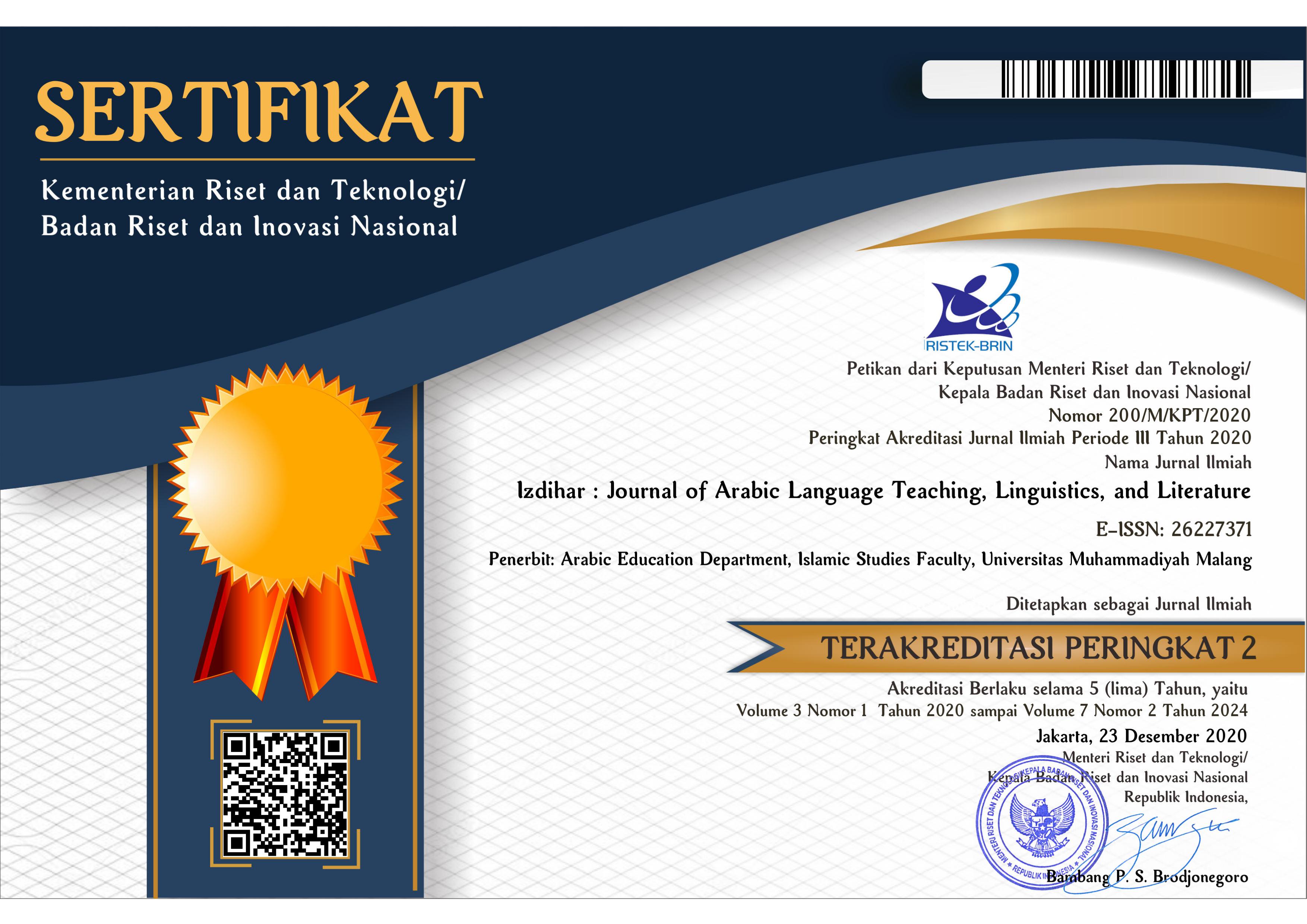Characteristic of Teaching Materials for Arabic Reading Skill with Inductive Approach
DOI:
https://doi.org/10.22219/jiz.v3i2.11193Keywords:
Himmati, Teaching Materials, Thu’aimahAbstract
Himmati is deliberately created as a textbook modification to recognize the Qur'an prepared for beginners. This research aimed to describe the characteristics of teaching material contained in Himmati. This research was a qualitative approach and content analysis of the perspective of Thu’aimah. It also belonged to library research with the main data source is a book, named Himmati: Modifikasi Pembelajaran Dasar Mengenali al-Qur’an from volume 1 to volume 5. The results showed that: 1) Generally, the teaching materials in Himmati were divided into 5 volumes which were presented inductively, namely the introduction of letters, words, tajweed, gharib, and verses in the Qur’an. Specifically, the teaching materials in Himmati were divided into 7 volumes which were presented with examples from the Qur'an and colored in the order of the frequency of visible light, from red to violet. The 1st volume focused on pronunciation, the 2ndA volume was on short vowels, long vowels, nunation (tanwin), and original sukuun, the 2ndB volume was on non-original sukuun and shadda, the 3rdA volume was on the law of nuun sukuun, nunation, germination nuun and miim, the 3rdB volume was on the law of miim sukuun, definite article al, and madd, the 4th volume was on the rule of exception, and the 5th volume was on the stop sign. The teaching materials in Himmati presented for beginners levelDownloads
References
Adriana, I. (2017). Perubahan Bunyi Pada Bacaan-Bacaan Gharib Dalam Alquran Menurut Tinjauan Fonologi Arab. OKARA: Jurnal Bahasa Dan Sastra, 11(1), 57–84. DOI: https://doi.org/10.19105/ojbs.v11i1.1238
Al-Daq, S. N. (2013). ’Adad ma fi al-Qur’an min Tikrar Huruf al-Mu’jam. Retrieved from al-Alukah al-Syar’iyah website: https://www.alukah.net/sharia/0/57490/
Al-Jamzuri, S. bin H., & Al-Maraqi, A. M. bin A. (n.d.). Nail al-Anfal fi Tarjamah Tuhfah al-Athfal. Semarang: Toha Putra.
Al-Rajihi, A. (1995). Ilm Lughah al-Tathbiqi wa Ta’lim al-’Arabiyah. Alexandria: Dar el-Ma’rifah el-Jami’ah.
Al-Ushaili, A. I. (2002). Tharaiq Tadris al-Lughah al-’Arabiyah li al-Nathiqin bi Lughat Ukhra. Riyadh: King Fahd.
Albab, U., Nuha, U., & Maskan, M. M. (2004). Yanbu’a: Thoriqoh Baca Tulis dan Menghafal al-Qur’an. Kudus: Pondok Tahfidh Yanbu’ul Qur’an.
Alhamuddin, A., Hamdani, F. F. R. S., Tandika, D., & Adwiyah, R. (2018). Developing Al-Quran Instruction Model Through 3a (Ajari Aku Al-Quran or Please Teach Me Al-Quran) To Improve Students’ Ability in Reading Al-Quran At Bandung Islamic University. International Journal of Education, 10(2), 95–100. DOI: https://doi.org/10.17509/ije.v10i2.8536
Anggara, S. A., & Habib, M. T. (2018). Al-Usus al-Muhimmah fi Tathwir al-Mawadd al-Ta’limiyah fi Ta’lim al-Lughah al-’Arabiyah. Lughawiyyāt : Jurnal Pendidikan Bahasa Dan Sastra Arab, 1(2). DOI: https://doi.org/10.38073/lughawiyyat.v1i2.133
Azaz, M. (2019). L1 Transfer Effects in the Production of Generic Plurals in L2 Arabic. MLJ: The Modern Language Journal, 103(1), 275–290. DOI: https://doi.org/10.1111/modl.12542
Benitez-Correa, C., Gonzalez-Torres, P., Ochoa-Cueva, C., & Vargas-Saritama, A. (2019). A Comparison Between Deductive and Inductive Approaches for Teaching EFL Grammar to High School Students. International Journal of Instruction, 12(1), 225–236. DOI: https://doi.org/10.29333/iji.2019.12115a
Bharadwaj, V. (2017). Colours: A Scientific Approach. International Journal of Research - Granthaalayah: Composition of Colours, Desember(1), 1–6. DOI: https://doi.org/10.5281/zenodo.888063
Corder, S. P. (1973). Introducing applied linguistics: Penguin Education. Michingan: Penguin Books.
Effendy, A. F. (2005). Metodologi Pengajaran Bahasa Arab (3rd ed.). Malang: Misykat Indonesia.
Effendy, A. F. (2013). Sudahkah Kita Mengenal Al-Quran? Malang: Misykat Indonesia.
Farid, E. K. (2018). Tathwir al-Mawadd al-Ta’limiyah li Maharah al-Istima’ li Daris al-Lughah al-’Arabiyah li ghair al-Nathiqin biha. ALSUNA: Journal of Arabic and English Language, 1(2), 114–120. DOI: https://doi.org/10.31538/alsuna.v1i2.79
Hakim, M. K. bin A. (2019). Needs Analysis of Arabic Guided Writing Material Using Task-Based Learning. Jurnal Al Bayan: Jurnal Jurusan Pendidikan Bahasa Arab, 11(2), 281–304. DOI: https://doi.org/10.24042/albayan.v
Humam, A. (1990). Iqro’: Cara Cepat Mebaca al-Qur’an. Yogyakarta: Balai Litbang LPTQ Nasional Team Tadarus “AMM.”
Islam, A. M. S. (2015). Faktor Demotivasi Pembelajaran Bahasa Arab. Arabiyât : Jurnal Pendidikan Bahasa Arab Dan Kebahasaaraban, 2(1), 1–16. DOI: https://doi.org/10.15408/a.v2i1.1511
Istiqomah, H. (2019). “HIMMATI” as a Modification Base Learning to Identify Al-Qur’an. Proceeding of International Conference on Islamic Education (ICIED), 4(1), 84–89. Retrieved from http://conferences.uin-malang.ac.id/index.php/icied/article/view/1070
Istiqomah, H., & Mahliatussikah, H. (2019). Musykilat al-Tarbiyyah Tuwajihuha al-Thalabah fi Ta’allum al-Lughah al-Arabiyah li Ghairi al-Nathiqin biha. Jurnal Al Bayan: Jurnal Jurusan Pendidikan Bahasa Arab, 11(2), 254–280. DOI: https://doi.org/10.24042/albayan.
Lubis, H., Lubis, S. A., & Azmi, F. (2018). Teacher Competency on Learning Al-Quran in Raudhatul Athfal At Medan. International Journal on Language, Research and Education Studies, 2(3), 312–321. DOI: https://doi.org/10.30575/2017/ijlres-2018091201
M Cloonan, M., & Fingeret, A. L. (2020). Developing teaching materials for learners in surgery. Surgery, 167(4), 689-692. DOI: https://doi.org/10.1016/j.surg.2019.05.056
Mahjoob, E. (2015). A Comparison of the Effectiveness of Inductive vs. Deductive Instruction of Grammar to EFL Students. Journal of Language, Linguistics and Literature, 1(5), 164–169. Retrieved from http://www.aiscience.org/journal/j3l
Mahmoud, H. N., & Shaker, M. M. (2019). The Citation of the Speech of Al-A’rab (Bedouin) in “Gharib Al-Qur’an”: A Linguistic Study. Journal of Tikrit University for the Humanities, 26(3), 158–180. DOI: https://doi.org/10.25130/hum.v26i3.586
Mallia, J. G. (2014). Inductive and Deductive Approaches to Teach English Grammar. AWEJ: Arab World English Journal, 5(2), 221–235. Retrieved from www.awej.org
Manshur, A. M. S. A. (1980). Ilm al-Lughah al-Nafsi. Riyadh: ’Imadah Syuun a-Maktabat - Jami’ah al-Malik Sa’ud.
Marzouk, R., & Kareh, S. El. (2018). An Evaluation of the Morphological Analysis of Egyptian Arabic TreeBank. In Intelligent Natural Language Processing: Trends and Applications (Vol. 740, pp. 637–658). DOI: https://doi.org/10.1007/978-3-319-67056-0_30
Mijlad, A., & El Younoussi, Y. (2019). Arabic text diacritization: Overview and solution. ACM International Conference Proceeding Series, 1–7. DOI: https://doi.org/10.1145/3368756.3369088
Munif, M. (2018). Pendidikan Karakter Dalam Bahan Ajar Bahasa Arab Kelas 3 Madrasah Ibtida’iyah Kurikukulum 2013. Islamic Review : Jurnal Riset Dan Kajian Keislaman, 7(2), 137–157. DOI: https://doi.org/10.35878/islamicreview.v7i2.142
Munjiah, M. (2012). Kaidah-Kaidah Imla’ (Teori dan Praktik). Malang: UIN Maliki Press.
Nabhan, S. bin S., & Al-Samarani, A. M. bin A. al-M. (n.d.). Syifa’ al-Jinan fi Tarjamah Hidayah al-Shibyan. Surabaya: Maktabah al-’Ashriyah.
Otaya, L. G., Anwar, H., & Husain, R. T. (2019). Estimating the Students’ Skill in Reciting and Writing Al-Qur’an at Faculty of Tarbiyah and Teacher Training IAIN Sultan Amai Gorontalo. Nadwa : Jurnal Pendidikan Islam, 13(1), 75–94. DOI: https://doi.org/10.21580/nw.2019.1.1.3590
Ryding, K. C. (2005). A Reference Grammar of Modern Standard Arabic. New York: Cambridge University Press.
Sadzili, H., Al-Ali, M. T., Masyhud, M., & Muaffa, A. (2000). Tilawati: Metode Praktis Cepat Lancar Belajar Membaca al-Qur’an untuk TK/TP al-Qur’an. Surabaya: Pesantren al-Qur’an Nurul Falah.
Supriyadi, T., & Julia, J. (2019). The problem of students in reading the Quran: A reflective-critical treatment through action research. International Journal of Instruction, 12(1), 311–326. DOI: https://doi.org/10.29333/iji.2019.12121a
Taib, J. M., Yusof, N. M., Jamil, H. M. T., Aris, H. R., & Satari, H. (2016). An Interactive Approach of an E-TajweedYaasin System. In Envisioning the Future of Online Learning (pp. 115–123). DOI: https://doi.org/10.1007/978-981-10-0954-9_10
Thu’aimah, R. A. (1958). Dalil ’Amal fi I’dad al-Mawadd al-Ta’limiyah li Baramij Ta’lim al-’Arabiyah. Makkah: Ma’had al-Lughah al-Arabiyah Jami’ah Ummul Qura.
Thu’aimah, R. A. (1986). Al-Maraji’ fi Ta’lim al-Lughah al-’Arabiyah li al-Nathiqin bi Lughat Ukhra (J. 2). Makkah: Ma’had al-Lughah al-Arabiyah Jami’ah Ummul Qura.
Wahab, M. A. (2015). Pembelajaran Bahasa Arab Di Era Posmetodern. ARABIYAT : Jurnal Pendidikan Bahasa Arab Dan Kebahasaaraban, 2(1), 59–74. DOI: https://doi.org/10.15408/a.v2i1.1519
Yeomans-Maldonado, G. (2017). Development of comprehension monitoring in beginner readers. Reading and Writing, 30(9), 2039–2067. DOI: https://doi.org/10.1007/s11145-017-9765-x
Yousfi, B., & Zeki, A. M. (2017). Holy Qur’an speech recognition system Imaalah checking rule for warsh recitation. IEEE 13th International Colloquium on Signal Processing & Its Applications (CSPA), 258–263. DOI: https://doi.org/10.1109/CSPA.2017.8064962
Zaghouani, W., Bouamor, H., Hawwari, A., Diab, M., Obeid, O., Ghoneim, M., … Oflazer, K. (2016). Guidelines and framework for a large scale Arabic diacritized corpus. Proceedings of the 10th International Conference on Language Resources and Evaluation, LREC 2016, 10, 3637–3643.
Zarkasyi, D. S. (1989). Qiroati: Metode Praktis Belajar Membaca al-Qur’an. Semarang: Yayasan Pendidikan al-Qur’an Raudhatul Mujawwidin.
Zerrouki, T., Shquier, M. M. A., Balla, A., Bousbia, N., Sakraoui, I., & Boudardara, F. (2019). Adapting espeak to Arabic language: Converting Arabic text to speech language using espeak. International Journal of Reasoning-Based Intelligent Systems, 11(1), 76–89. DOI: https://doi.org/10.1504/ijris.2019.098056
Downloads
Published
How to Cite
Issue
Section
License
Copyright Notice
Authors who publish with this journal agree to the following terms:
- Authors retain copyright and grant the journal right of first publication with the work simultaneously licensed under a Creative Commons Attribution-ShareAlike 4.0 International License that allows others to share the work with an acknowledgment of the work's authorship and initial publication in this journal.
- Authors are able to enter into separate, additional contractual arrangements for the non-exclusive distribution of the journal's published version of the work (e.g., post it to an institutional repository or publish it in a book), with an acknowledgment of its initial publication in this journal.
- Authors are permitted and encouraged to post their work online (e.g., in institutional repositories or on their website) prior to and during the submission process, as it can lead to productive exchanges, as well as earlier and greater citation of published work (See The Effect of Open Access).
Copyright (c) 2019 Izdihar : Journal of Arabic Language Teaching, Linguistics, and Literature

This work is licensed under a Creative Commons Attribution-ShareAlike 4.0 International License.

















